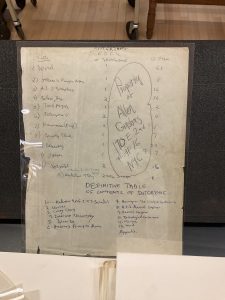Interested in the persistent cultural influence of the Beat Poets, Alex Cheng visited the library this summer to see what the archives could tell him about the writing process and social networks of Allen Ginsberg, Jack Kerouac, and William Burroughs. Getting a head start on most researchers, Alex took some time from his high school summer break to delve into the archives. Below, he shares some of what he learned from his visit…
What is your project title?
The Cultural and Literary Influence of the Beat Poets
What brings you to Columbia’s Rare Book & Manuscript Library?
I attend the Hotchkiss School and am a MacLeish Scholar, a school program focused on literary research. The program, named after Archibald MacLeish, who graduated from Hotchkiss in 1911, begins with a two week research period in New York City, where students conduct literary archival research at various library such as Columbia, NYU, Barnard, and the Berg and Pforzheimer Collections at the New York Public Library. The two-week session is followed by a year-long course that culminates in a final research paper drawing from researched material. Personally, I was intrigued by Columbia’s rich Allen Ginsberg archive, as I am looking into the cultural and literary influence of the Beat Poets. I’ve always been in love with the idea of New York; as a poet and short-story writer, the city has always been a central part of my works. This is why I landed on the Beats and the New York School as my research project — to gain a greater understanding of the City’s rich tradition of art, and how it has inspired artists before me. Columbia’s archive held a great diversity of material about Ginsberg, from his typescripts and photos, to his correspondence with his closest friends and contemporaries such as Jack Keruoac and William S. Burroughs.
How long have you been using RBML materials (for this and/or previous research)?
This is my first time conducting archival research using RBML materials. It was a wonderful and eye-opening experience to be able to look into the material of some of my favorite writers and poets.
What have you found? Did you come here knowing this material was here?
I discovered so many rich insights into the behind-the-scenes work of so many of the Beat Poets that I had not realized existed. One piece of archival material that especially stood out to me was a manuscript that Allen Ginsberg and William Burroughs created together regarding Burroughs’s most renowned piece — Naked Lunch. Published in 1959 as a radical and controversial work, Naked Lunch consists of twelve chapters/vignettes that can be read in any order. This particular manuscript is from the spring of 1957 when Naked Lunch was still tentatively named Interzone. The manuscript shows Ginsberg completely altering the order of the soon-to-be-published novel, thus in many ways reversing the order readers experienced it. I am amazed by the effect this one manuscript has had on the perception and structure of such an influential work.
What have you found that’s surprised or perplexed you?
One finding that really surprised me was being able to deep-dive into dynamics between Ginsberg, Keruac, and Burroughs. While I knew the Beat collection was very rich, one area which I did not expect to find so much rich information was Ginsberg’s communications with his friends. By looking at these archives, I was able to grasp an understanding of the dynamic between these trailblazing poets and friends. Before coming to Columbia, I had always thought their friendship to be just that — a bond between friends that shared work and ideas. However, my work in the archives revealed much more. Starting with the letters from their days attending Columbia (although Kerouac dropped out), and extending all the way through their professional careers, a clear image of the influences which they all had on each other began to materialize. Their friendship was much more complex than I originally believed. The archives detail times Keruoac, Ginsberg, and Burroughs fought, checked in on each other, set up spontaneously rondevoux times, traveled, exchanged religious beliefs, shared snippets of their lives, and were each other’s lovers. The correspondences truly brought another dimension of the authors to life that cannot be access by simply reading their published works.
What advice do you have for other researchers or students interested in using RBML’s special collections?
One thing is to always ask the archivists; they are extremely nice, helpful, and knowledgeable. Although as a first time researcher I was initially nervous, Vianca was always there to assist me whenever I needed it. If you have any questions or concerns, please leverage them!
